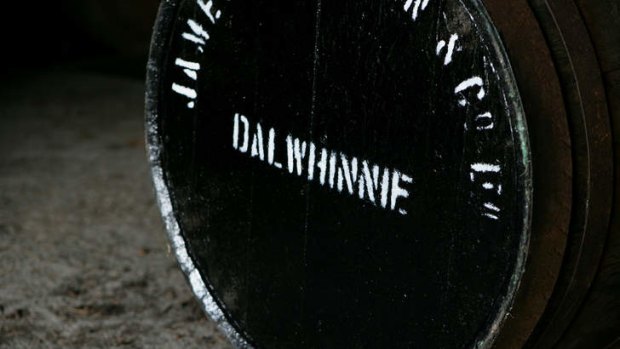
Dalwhinnie Distillery.
Sheriden Rhodes mixes it up with chocolate.
I’m at Scotland’s highest distillery and even at the tail end of a northern hemisphere summer, it feels like a particularly cruel winter’s day back home. The surrounding highlands are lush green, a sure sign the area receives more than its fair share of rain. Dalwhinnie Distillery is not only the country’s highest distillery, it also lays claim to being the coldest, with an average annual temperature of just six degrees. ‘‘Why on earth, you may think,’’ asks the unknown author of this fitting epithet, ‘‘would anybody choose to build a distillery in this desolate, wind-sliced, rain-lashed patch of Highland wilderness?’’ Today it still begs the question.
One reason apparently is Dalwhinnie’s location. Sited among the peaks and valleys of the Scottish highlands, it was once a popular haunt of smugglers and cattle drovers on their way to the markets of the south – in fact Dalwhinnie means meeting place in Gaelic. It also, ideally, has access to the pure, clear spring water of Lochan-Doire-Uaine (or Loch of the green thicket), above the snow line. The water there feeds the Allt an t‘Sluic, a burn that flows over the local peat and into the Spey River. No other distillery is allowed to use water from this source, giving Dalwhinnie’s single malts their distinctive, smoky highland mouth feel.
While the warming effect of whisky may be purely physiological, it’s without doubt an appealing drink in cooler climes, and I’m beginning to understand why whisky is Scotland’s national drink of choice.
Even at the ungodly hour of 10am, with the wind-whipping my inadequate lightweight jacket, I find myself looking forward to my first wee dram of the day. But what makes this particular whisky tasting even more appealing – for a whisky rookie like myself – is its unusual pairing with chocolate.
Scotch whisky has long been matched with the simple oatcake and cheese, yet tradition has been nudged aside for couplings of Dalwhinnie’s single malts with bespoke chocolate from Iain Burnett – The Highland Chocolatier. ‘‘The chocolate coats the taste buds with cocoa fat, which enhances the taste of the whisky,’’ our guide Ewan Mackintosh explains, who is Dalwhinnie’s brand home manager.
He has just given us a tour of the distillery where most of its employees come from families that have worked at Dalwhinnie, now owned by global spirits giant Diageo, for generations.
The distillery itself is particularly fetching, with its beautifully maintained whitewashed buildings and distinctive pagodas set against a backdrop of some of Scotland’s most beautiful scenery. Its traditional wooden wash backs and unique lye pipes leading from the tops of the stills are still used.
Inside the tasting room, I’m handed a placemat with a description of six different chocolates and six matching classic malts. My personal favourite is the Oban, a 14-yearold single malt whisky from the west highlands, teamed with an Assam tea and cardoman truffle. Another interesting match is the 10-year-old Talisker with a raspberry and black pepper truffle, which enhances the whisky’s sweet and slightly smoky characteristics.
While I can’t say I’m a convert to early morning whisky tastings, I’m surprised at how the chocolate helps me appreciate the full potential of single malt whisky on the palate.
Although tasting Scotch whisky at its source, surrounded by Scotland’s magnificent desolate countryside, certainly heightens the experience.
The writer was a guest of Visit Britain, Virgin Atlantic and Johnnie Walker.
Sign up for the Traveller Deals newsletter
Get exclusive travel deals delivered straight to your inbox. Sign up now.